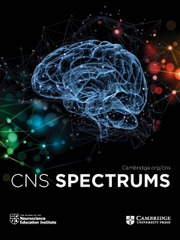No CrossRef data available.
Article contents
Determining Clinician Factors for Implementing LAIs and Defeating Barriers (DECIDE) Study: Describing Differences Between Clinicians Based on Their LAI Use and Archetype
Published online by Cambridge University Press: 10 January 2025
Abstract
Long-acting injectable antipsychotics (LAIs) reduce relapses in schizophrenia; however, most healthcare professionals (HCPs) reserve LAIs for nonadherence to oral antipsychotics (OAs) or severe disease.
US HCPs were surveyed regarding attitudes and perceptions toward LAIs for schizophrenia and LAI selection preferences. Respondents were grouped by LAI use (high [≥31% of patients using LAIs], low [≤14% using LAIs]; mid not analyzed) and archetype based on response to, “Which of the following best fits the current way you view your use of [LAIs] for your patients with schizophrenia?” (see responses below).
Respondents (106 high, 130 low LAI use) were distributed across early LAI use (n=123), severity-reserved (n=88), adherence-reserved (n=113), and LAI-hesitant (n=56) archetypes.
Across all groups, HCPs estimated OA nonadherence in their practice (21%– 32%) to be lower than for patients nationwide (50%– 56%). Overall, 27% were dissatisfied with their LAI:OA use ratio, most thinking their OA use was too high. In all groups, side effects/tolerability was ranked as most important when choosing an LAI and “preference for the molecule” was ranked least important. Overall, 71%– 77% of HCPs were somewhat/much more likely to use a particular LAI based on multiple injection site options, small/on par needle, and price, and 63%– 82% of HCPs were somewhat/much more likely to select an LAI dosed once monthly or less often compared with an LAI dosed once every 2 weeks (8%). HCPs with high LAI use or early LAI use archetype were more likely to disagree that managing patients with schizophrenia increased their stress (64% and 63% vs 27%-45%, P<.05 each) and/or left them feeling “burned out” (77% and 79% vs 50%– 64%, P<.05 each).
Compared with other groups, greater proportions with high LAI use or early LAI use archetype consistently read new LAI publications (18% and 19% vs 0%– 5%, P<.01) and were confident in key aspects of LAI treatment (ie, dosing, managing side effects, access; 67%– 74% and 59%– 70% vs 11%– 57%, P<.05 each).
HCPs with low LAI use estimated the proportion of patients who initially refuse LAIs to be higher (mean, 55%) than those with low LAI use (44%, P<.01); there were no differences among archetypes (49%– 54%). HCPs with high LAI use or early LAI use archetype were more likely to “use any means necessary to ensure that a patient is on an LAI” vs other groups (44% and 51% vs 5%– 22%, P<.01 each) or had used guardianship to assist with treatment (70% and 69% vs 32%– 56%, P<.05 each); greater proportions with high LAI use or early LAI use archetype strongly agreed it was “worth [their] time to resolve issues with the insurance company” (42% and 45% vs 16%– 30%, P<.05 each) and were confident they would be able to do so (23% and 20% vs 2%– 11%, P<.05 each). Greater proportions of HCPs with early LAI use archetype vs the severity-reserved archetype strongly agreed that they attempt to determine the patient’s/caregiver’s preferred role before involving them (43% vs 27%, P<.05) and encourage them to participate (72% vs 57%, P<.05) in shared decision-making.
Comparing HCPs with high LAI use or early LAI use archetype vs other groups, multiple factors (eg, attitudes, preferences, training, knowledge base) combine to influence LAI use. These results highlight considerations for developing educational materials to increase LAI use in this population.
Teva Branded Pharmaceutical Products R&D, Inc.
Information
- Type
- Abstracts
- Information
- Copyright
- © The Author(s), 2025. Published by Cambridge University Press

